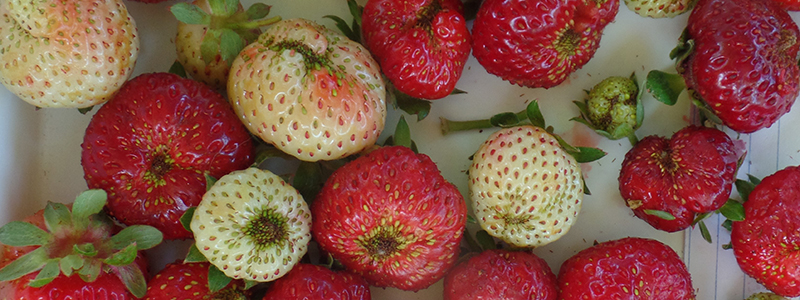
Mid-Late Season Pest Management for Day Neutral Strawberries
Thrips:
- Appearance: Adult thrips are slender, small insects about .03 inch (0.8 mm). Adults have feathery wings and vary in color from yellow to dark brown, and nymphs are white or yellowish with small dark eyes.
- Impact: Thrips feed on strawberry blossoms, causing the stigmas and anthers to turn brown and wither prematurely, but not before fertilization has occurred. As fruit develops, it can cause a russeting (Type I bronzing) of the fruit around the cap.
- Management and More Information: See the Pacific Northwest Insect Management Handbook’s entry on thrips.
Lygus
- Appearance: Adults are .25 to .5 inches long, oval, and rather flattened. Adults are greenish to brownish and have a distinct yellow or pale green “V” shape on their backs. Immature forms are pale green and look like an aphid but move more quickly. Nymphs are wingless, green, and characterized by five black dots on the back.
- Impact: Lygus feeds on buds, bloom, and immature fruits, resulting in deformed fruits (cat-facing), which reduces yield and fruit quality.
- Management and more information: See the Pacific Northwest Insect Management Handbook’s entry on lygus.
Spotted-wing Drosophila:
- Appearance: SWD are small (2-3 mm) with red eyes. SWD male flies have a black spot on the tip of each wing and two leg bands on each front leg. The female has a large serrated ovipositor that can penetrate soft-skinned fruit, such as berries and stone fruit.
- Impact: Female SWD can lay up to three eggs at a time and several hundred in her lifetime. Eggs hatch soon into larvae (small white maggots) that feed inside the fruit, causing fruit flesh to soften and discolor. Fruit surface will show depressions that leak fruit fluids.
- Management and more information: See the Pacific Northwest Insect Management Handbook’s entry on Spotted-wing Drosophila.
Twospotted Spider Mite:
- Appearance: Adults are 2- 3 mm long, have eight legs, and are tan or greenish with a dark spot on each side of their backs. They are often found on the underside of leaves in webbing.]
- Impact: Their feeding reduces plant vigor and may cause leaves to turn brown, curl and drop off prematurely, which reduces yield.
- Management and more information: See the Pacific Northwest Insect Management Handbooks entry on Twospotted spider mites.